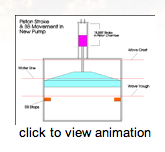 Renewable energy doesn’t stop with earth, sun and wind. Now water is becoming a viable source for alternative power. Texas A&M has put Renewable Energy Oceanwave Technology from Indpendent Natural Resources to the test for three months in the Gulf of Mexico. The university says the SEADOG Pump is a preliminary success.
Renewable energy doesn’t stop with earth, sun and wind. Now water is becoming a viable source for alternative power. Texas A&M has put Renewable Energy Oceanwave Technology from Indpendent Natural Resources to the test for three months in the Gulf of Mexico. The university says the SEADOG Pump is a preliminary success.
Researchers praised the pump’s design features for good mechanical efficiency that absorbs most of the potential energy and a significant amount of the kinetic energy content in the wave. This report further validates findings from a 21-day sea trial conducted in January of 2007 which compares the amount of energy SEADOG Pump can extract per square mile of deployment compared to other ocean, wind and solar renewable technologies. Because the pumps can be deployed in close proximity to each other, INRI(TM) estimates that they will produce five to 20 times more power per square mile than other technologies.
Generally speaking, wave energy is captured by engineered devices or components attached to stationary or floating structures that are set in motion by waves or swells on the surface of the ocean. Most wave energy technologies grow in cost because the specified equipment is sensitive to corrosive seawater and has intermittency issues similar to wind and solar energy. SEADOG Pump on the other hand, separates itself from other technologies on the market by using a simple pump design with few moving parts and no electronics. Multiple pumps are deployed in fields depending on how much power or water is desired. In addition, the SEADOG Pump moves large volumes of water to shore where it can be stored until needed for energy production or desalination. This ability to store energy removes the intermittency issues associated with other renewable energy technologies.
The lack of sufficient fresh water is a growing concern in many regions of the world, and seawater desalination is increasingly essential; Texas alone has more than 100 desalination plants. To further prove the SEADOG Pump’s commercial viability, INRI(TM) plans to launch an 18-pump field in the Gulf of Mexico between Galveston and Freeport, Texas. This commercial demonstration facility will desalinate seawater using the power generated by the 18 SEADOG Pumps.
Most wave-energy technologies involve off-shore electrical generation requiring the transmission of power to shore-based electrical grids. The SEADOG Pump captures energy from ocean swells or waves to pump seawater to land-based or sea-based holding areas, where the water can be returned to the ocean through turbines, thereby producing inexpensive, renewable electricity.

